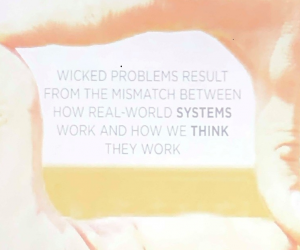Exploration of Systems Thinking
by Casey Gardner
We began our new journey into systems thinking with a broad question- What is knowledge? This was an interesting question since we as humans just “know” what knowledge is. A simple description appeared to be that knowledge is our experience, practice, growth and flexibility. It is based on our mental models that have been created by our life experiences and is quite adaptive. To build on knowledge, one must be receptive of new or opposing information as well as being self-aware of your own mindfulness and curiosity.
We proceeded on with this discussion by dipping our feet into the basics of systems thinking. By applying systems thinking to our daily lives we may be able to improve our own thinking, education and communication as well as develop adaptive organizations and a shared understanding of complex issues. To begin understanding this new technique we dove into the four basic principles of “DSRP” that make up this thought pattern. D stands for Distinction and takes a thought or object and identifies it as its own “thing”. To use as an example, we discussed a peanut butter sandwich as being its own unique  object. The S is for System and breaks that object into different parts. In the sandwich example this has the sandwich becoming 3 parts: the bread, peanut butter and jelly. The R is for Relationship and had us deciding how all of these different parts relate to each other. The peanut butter and the jelly both relate to the bread by being spread upon it, as well as the peanut butter and the jelly by being placed together. This moved us to the final letter P or Perspective. We discussed how this peanut butter and jelly sandwich was able to be seen in different points of view, which would alter how it would be seen. From the “eaters” point of view it would be sustenance, and the flavor and ratios of the ingredients would matter. From the “makers” perspective it could be viewed as work and cost. The maker would need other parts for this such as the ingredients and a plate and knife. This could be broken down even further by looking at the perspective of the food manufacturers and the farmers who provided the wheat, nuts and berries.
object. The S is for System and breaks that object into different parts. In the sandwich example this has the sandwich becoming 3 parts: the bread, peanut butter and jelly. The R is for Relationship and had us deciding how all of these different parts relate to each other. The peanut butter and the jelly both relate to the bread by being spread upon it, as well as the peanut butter and the jelly by being placed together. This moved us to the final letter P or Perspective. We discussed how this peanut butter and jelly sandwich was able to be seen in different points of view, which would alter how it would be seen. From the “eaters” point of view it would be sustenance, and the flavor and ratios of the ingredients would matter. From the “makers” perspective it could be viewed as work and cost. The maker would need other parts for this such as the ingredients and a plate and knife. This could be broken down even further by looking at the perspective of the food manufacturers and the farmers who provided the wheat, nuts and berries.
We need to keep growing, stay curious and look at all angles and possibilities to make a difference in the world.
By utilizing this process of thought, you can take any object, idea or problem and break it down to see the whole system and each function or purpose. We are never too old to grow our knowledge and change the way that we face problems or view situations. Utilizing the systems thinking process can create a more adaptive approach for individuals in both their life and organizations. We can solve problems that may have appeared to hit a road block, or are just stuck in the “old ways” of being done. We need to keep growing, stay curious and look at all angles and possibilities to make a difference in the world.



